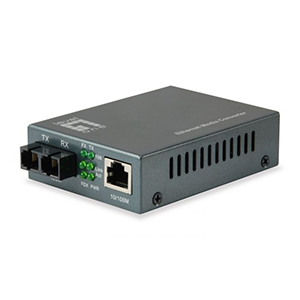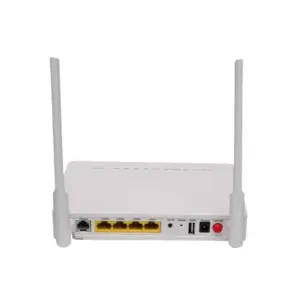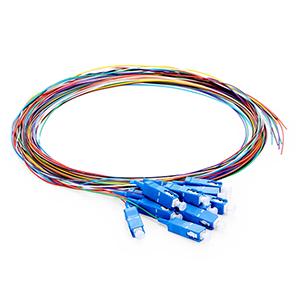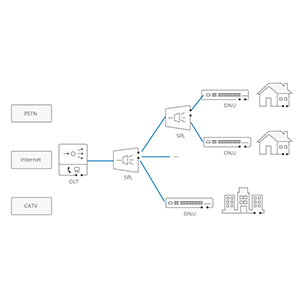I am pleased to introduce you to the 10GbE SFP (10 Gigabit Ethernet Small Form-Factor Pluggable) optical module transmitter. In this article, I will explore the definition, basic principles and characteristics and advantages of 10GbE SFP optical module transmitter in different application fields.
In network communications, the 10GbE SFP optical module transmitter is an important device, which provides high-speed data transmission capabilities. It adopts a small size and pluggable design, making it more flexible and convenient in deployment and configuration.
10GbE SFP optical module transmitter introduction
Definition and rationale:
The 10GbE SFP (10 Gigabit Ethernet Small Form-Factor Pluggable) optical module transmitter is an optical module used for 10 Gigabit Ethernet (10GbE). It provides the ability to transmit signals through optical fiber, allowing high-speed data transmission through optical fiber media in the network.
Basic principle: The 10GbE SFP optical module transmitter works based on the principle of optical fiber communication. It uses a photoelectric converter to convert electrical signals into optical signals and transmits the optical signals through optical fibers. At the receiving end, the optical signal is again converted into an electrical signal through a photoelectric converter for processing and transmission in network equipment.
Optical module type:
As a kind of optical module, the 10GbE SFP optical module transmitter has the following characteristics and uses:
-
Small size: 10GbE SFP optical module transmitter adopts small size and is usually called SFP or SFP+ module. Their small size makes them suitable for high-density network equipment such as switches and routers, which can accommodate more optical modules in a limited space.
-
High-speed transmission: 10GbE SFP optical module transmitter supports high-speed transmission of 10 Gigabit Ethernet. They are capable of delivering data transfer rates of up to 10 Gbps, making them suitable for applications requiring large bandwidth, such as data centers, cloud computing and large-scale networks.
-
Multi-mode and single-mode optical fiber support: 10GbE SFP optical module transmitter can be used for multi-mode optical fiber and single-mode optical fiber transmission. Multimode fiber is suitable for short-distance transmission, while single-mode fiber is suitable for long-distance transmission. This makes the 10GbE SFP optical module transmitter very flexible and the appropriate fiber type can be selected according to the network needs.
-
Hot-swappable function: 10GbE SFP optical module transmitters support hot-swappable function, which means they can be plugged in or out during operation without shutting down the entire device. This makes it easy to replace, upgrade and maintain optical modules while reducing interruption time to the network.
10GbE SFP optical module transmitter is a commonly used optical module type that is widely used in modern high-speed networks. They provide high-speed, flexible and reliable fiber optic transmission solutions, delivering high performance and scalability for a variety of application scenarios.
Application fields of 10GbE SFP optical module transmitter
Data center network:
10GbE SFP optical module transmitters are widely used in data center networks and are mainly used to support high-bandwidth and low-latency data transmission. The following are some typical application scenarios:
-
Server interconnection: In data centers, 10GbE SFP optical module transmitters can be used to connect communications between servers. They provide high-speed server interconnection, support large-scale data transfer and fast response times, thereby meeting the needs of data centers for high-performance networks.
-
Storage network: 10GbE SFP optical module transmitter is often used in storage networks to connect storage devices (such as SAN, NAS) and servers. They are able to provide high-bandwidth and low-latency data transmission to meet the high-speed and reliable needs for storage access.
-
Virtualization environment: In a virtualization environment, 10GbE SFP optical module transmitter is used to connect virtualization hosts and network devices. They support high-speed data transmission and network traffic between virtual machines, providing high-performance and low-latency network connections to meet the needs of large-scale virtualization environments.
Corporate network:
10GbE SFP optical module transmitters also have important applications in enterprise networks to meet the needs of large-scale data transmission and high-speed interconnection. Here are some common application scenarios:
-
Core switch connection: 10GbE SFP optical module transmitter can be used to connect the core switch of the enterprise network, providing high bandwidth and reliable data transmission. They support high-speed aggregation and traffic management of enterprise networks, ensuring high performance and scalability of the network.
-
Data backup and recovery: For enterprises that require large-scale data backup and recovery, 10GbE SFP optical module transmitters provide high-bandwidth transmission capabilities. They can transfer large amounts of data quickly and reliably, speed up backup and recovery, and improve data availability and reliability.
-
Remote office and branch office connections: For enterprises with distributed office environments or branch offices, 10GbE SFP optical module transmitters can be used to connect remote office and branch office networks. They provide high-speed interconnection capabilities, support remote access, data sharing and collaborative work, improving enterprise efficiency and flexibility.
In short, 10GbE SFP optical module transmitters play an important role in both data center networks and enterprise networks, providing high-speed, reliable data transmission and interconnection capabilities. They meet the needs of modern networks for large bandwidth, low latency, and high performance, and promote the development and innovation of data centers and enterprise networks.
Features and advantages of 10GbE SFP optical module transmitter
Transmission rate:
One of the main features of the 10GbE SFP optical module transmitter is its high transmission rate, reaching 10 Gbps (Gigabits per second). This makes them ideal for handling high-speed data transfers and smooth video transfers. Whether in data centers, enterprise networks or other scenarios with high bandwidth requirements, 10GbE SFP optical module transmitters can provide fast and reliable data transmission capabilities to meet the demand for high-speed networks.
Miniaturized size:
10GbE SFP optical module transmitter adopts miniaturized size and is often called SFP or SFP+ module. This miniaturized design offers the following advantages:
-
High port density: Due to its small size, the 10GbE SFP optical module transmitter can accommodate more optical modules in a limited space. This enables network devices such as switches and routers to support more ports, providing more connectivity options and flexibility.
-
Flexibility: The small size makes the 10GbE SFP optical module transmitter very flexible and can be easily plugged, unplugged and replaced. They support hot-swappable functionality, allowing optical modules to be inserted or removed without shutting down the entire device. This makes it easy to upgrade, replace and maintain optical modules, reducing interruption time to the network.
-
Adapt to a variety of network equipment: Due to its small size and universal interface design, the 10GbE SFP optical module transmitter can be used in a variety of network equipment. Whether in data centers, enterprise networks, or other network environments, they provide a standardized fiber optic interface that allows them to interoperate with a variety of compatible devices and platforms.
Therefore, the miniaturized size of 10GbE SFP optical module transmitters provides higher port density and flexibility for the network. They meet the needs of high-density deployments and provide high-speed, reliable fiber optic connectivity in limited spaces. At the same time, this miniaturized design also facilitates the upgrade and maintenance of optical modules, improving the scalability and reliability of the network.
Optical module types of 10GbE SFP optical module transmitter
Single mode optical module:
The 10GbE SFP single-mode optical module transmitter uses single-mode optical fiber for data transmission and has the following characteristics and applicable scenarios:
Features:
-
High transmission distance: Single-mode fiber has a smaller fiber core diameter and lower refractive index, which can achieve longer transmission distances. 10GbE SFP single-mode optical module transmitter can support long-distance data transmission needs, usually covering a range of tens of kilometers.
-
Narrow bandwidth: Single-mode optical fiber has a narrow bandwidth and is suitable for high-speed data transmission. They can provide higher transmission rates and lower transmission losses to meet network requirements for high bandwidth and low latency.
Applicable scene:
-
Long-distance transmission: Due to the long transmission distance of single-mode optical fiber, 10GbE SFP single-mode optical module transmitter is often used in scenarios that require long-distance data transmission, such as network connections across cities or across different geographical locations.
-
Fiber optic backbone network: Single-mode optical fiber is usually used to build fiber optic backbone networks to connect different data centers, enterprise branches, or network nodes. 10GbE SFP single-mode optical module transmitter provides high-speed and reliable connections in optical fiber backbone networks to meet the needs of large-scale data transmission.
Multimode optical module:
The 10GbE SFP multi-mode optical module transmitter uses multi-mode optical fiber for data transmission and has the following characteristics and applicable scenarios:
Features:
-
Low cost: Compared with single-mode optical modules, multi-mode optical modules have lower manufacturing costs, making them an economical choice.
-
Short-distance transmission: Multimode optical fiber has a larger fiber core diameter and higher refractive index, and is suitable for short-distance transmission. 10GbE SFP multi-mode optical module transmitters are usually suitable for connections between devices within local area networks (LAN) and data centers, and the transmission distance is usually within a few hundred meters.
Applicable scene:
-
Internal connections in data centers: Since multimode optical fiber is suitable for short-distance transmission, 10GbE SFP multimode optical module transmitters are often used for connections between servers, storage devices and network devices inside data centers. They provide high-speed, low-latency connections that meet data center needs for large-scale data transmission and high-performance networking.
-
Local area network (LAN) connection: Multimode optical fiber is also commonly used to connect devices in local area networks (LAN), such as office networks, campus networks, etc. 10GbE SFP multi-mode optical module transmitter can be used to connect switches, routers and servers, providing high-speed and reliable LAN connections.
To sum up, the 10GbE SFP optical module transmitter can choose single-mode optical modules or multi-mode optical modules according to different fiber types. Single-mode optical modules are suitable for long-distance transmission requirements, while multi-mode optical modules are suitable for short-distance transmission requirements. According to the specific network environment and transmission distance requirements, selecting the appropriate optical module type can meet the data transmission in different scenarios.
10GbE SFP optical module transmitter compatibility and slot interface
Compatibility points:
The 10GbE SFP optical module transmitter has the following points in terms of compatibility:
-
Standardized interface: The 10GbE SFP optical module transmitter adopts standardized interface specifications to ensure compatibility with other optical modules and equipment. These interface specifications define the size, electrical characteristics and communication protocols of optical modules so that optical modules produced by different manufacturers can be used interchangeably.
-
MSA (Multi-Source Agreement) compatibility: SFP optical module transmitters usually follow the MSA (Multi-Source Agreement) protocol, which is a specification jointly developed by multiple manufacturers to ensure the interoperability and compatibility of optical modules sex. By following the MSA specification, manufacturers can produce optical modules that meet the standard so that they can match other devices that meet the same specification.
-
Multi-mode compatibility: 10GbE SFP optical module transmitters usually support multiple fiber types, including single-mode and multi-mode fiber. This allows them to match different types of optical fibers and adapt to different transmission needs.
Slot interface:
Common slot interface types of 10GbE SFP optical module transmitters include the following:
-
LC interface: LC (Lucent Connector) is a common fiber optic connector interface type and one of the most common interface types in 10GbE SFP optical module transmitters. The LC interface is small and reliable, suitable for high-density fiber optic connections.
-
SC interface: SC (Subscriber Connector) is another common fiber optic connector interface type, used to connect 10GbE SFP optical module transmitters and other fiber optic equipment. The SC interface is relatively large and suitable for general fiber optic connection needs.
-
MPO/MTP interface: MPO (Multi-fiber Push-On) or MTP (Multi-fiber Termination Push-on) is a multi-fiber connector interface type used to support high-density optical fiber connections. They can support simultaneous connections of multiple optical fibers and are suitable for scenarios such as data centers that require a large number of optical fiber connections.
These slot interface types are standardized and compatible with corresponding fiber optic connectors. According to the actual needs and the interface type of the device, you can select the corresponding slot interface to connect the 10GbE SFP optical module transmitter and other devices.
Note that specific compatibility and slot interface types may vary by manufacturer and device model. When selecting and using a 10GbE SFP optical module transmitter, it is recommended to refer to the manufacturer’s specifications and compatibility list to ensure matching and compatibility between the optical module and the device.
Deployment and configuration of 10GbE SFP optical module transmitter
Optical module installation:
The following is the optical module installation guide for the 10GbE SFP optical module transmitter:
-
Preparation: Make sure the device and optical module are powered off. Check the compatibility of optical modules and devices, and confirm the fiber type and connector type used.
-
Insert the optical module: Gently insert the 10GbE SFP optical module into the corresponding slot of the device, making sure that the optical module is aligned with the slot. Be careful not to insert with excessive force to avoid damaging the device or optical module.
-
Fix the optical module: Depending on the design of the device, you may need to use screws or buckles to fix the optical module to the slot. Follow the equipment manufacturer’s instructions to secure the optical module.
-
Connect the optical fiber: Connect the optical fiber connector to the interface of the optical module. Choose the correct connection method such as LC, SC or MPO based on fiber type and connector type. Make sure the connection is secure and the fiber is not bent or damaged.
-
Power supply and power on: After completing the installation of the optical module, power on the device and power on. The device will recognize the optical module and complete the initialization process.
Network Configuration:
The following is the network configuration method of the 10GbE SFP optical module transmitter:
-
Link aggregation: If you need to increase bandwidth or improve redundancy, you can use link aggregation technology to connect multiple 10GbE SFP optical module transmitters together. Higher total bandwidth can be achieved by aggregating the ports of multiple optical module transmitters and redundancy protection. Link aggregation needs to be configured on the corresponding network device, such as a switch or router.
-
Optical module parameter adjustment: 10GbE SFP optical module transmitter usually has some adjustable parameters to optimize fiber transmission performance. These parameters can include transmit power, receive sensitivity, fiber type, etc. According to the specific network environment and requirements, corresponding parameter adjustments can be made through the device’s management interface or command line interface.
-
Network configuration adjustment: When deploying 10GbE SFP optical module transmitter, the configuration of the network device may need to be adjusted to adapt to the new connection. This may involve IP address configuration, routing configuration, VLAN configuration, etc. Make corresponding network configuration adjustments based on specific network planning and needs.
It should be noted that the specific deployment and configuration methods may vary depending on the device manufacturer and model. When deploying and configuring the 10GbE SFP optical module transmitter, it is recommended to refer to the user manual, configuration guide or technical support provided by the manufacturer to ensure that the deployment and configuration process is completed correctly and smoothly.
Summarize:
Whether in a data center network or an enterprise network, choosing a suitable 10GbE SFP optical module transmitter will provide your network with stable and efficient data transmission. As technology continues to advance and demand continues to grow, 10GbE SFP optical module transmitters will continue to play an important role and promote further development in the field of network communications.
We hope this article has provided you with valuable information and we are here to help if you have any further questions or needs. Choose 10GbE SFP optical module transmitter to make your network connection faster and more reliable!
- What is 10G SFP?
- What is the difference between SFP 10G and SFP+ 10G?
- Can SFP run at 10G?
- Can 10Gb SFP run at 2.5 GB?
- What is the difference between 10gb SFP and SFP+?
- What is the difference between 10G SFP and 25g SFP?
- Does SFP support 2.5 Gbps?
- How do I know if my SFP is 10G?
- Is SFP-10G-SR single-mode or multimode?





